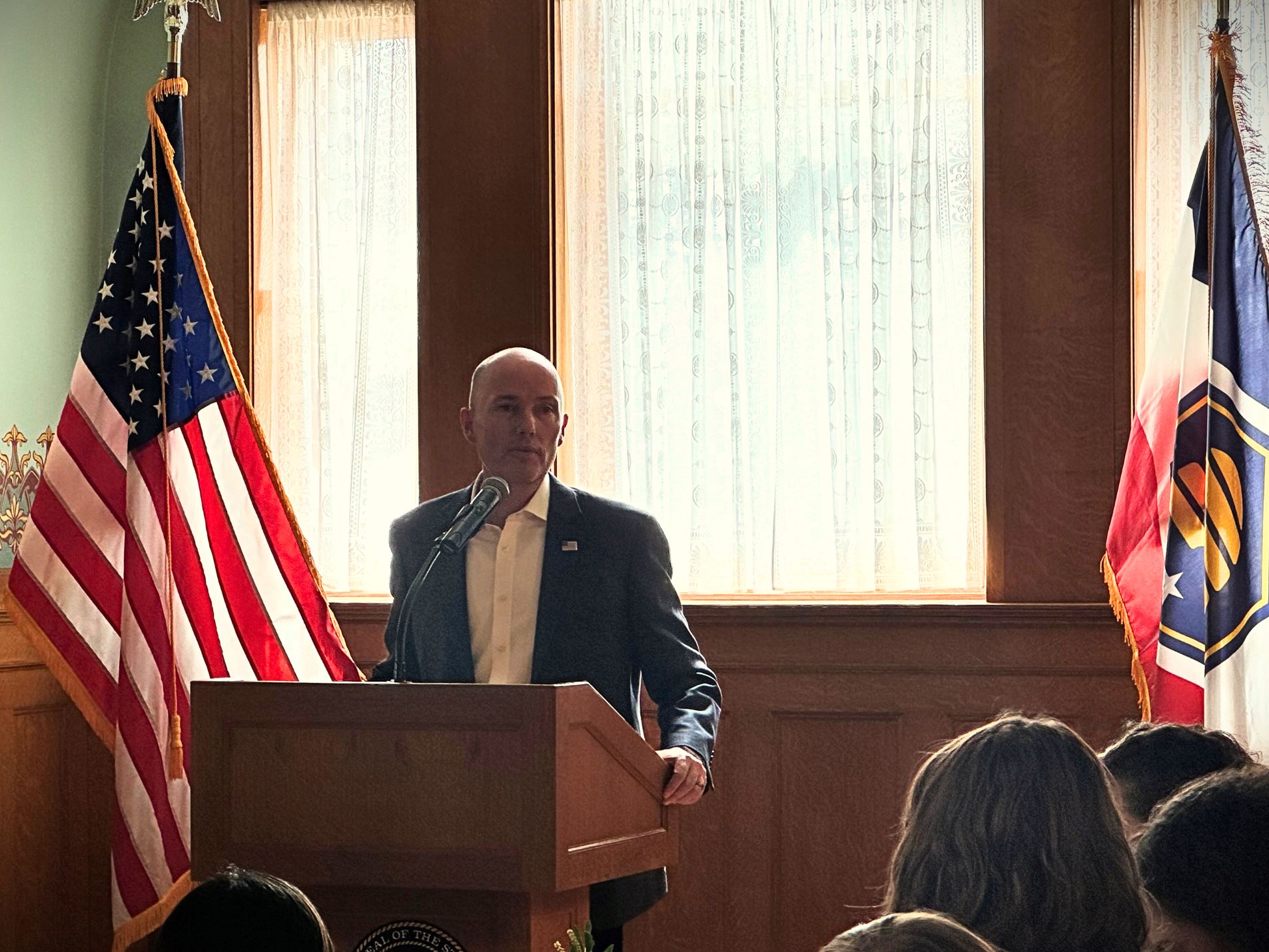DOWNLOAD THE COVER LETTER HERE.
May 24, 2019
The Honorable Lamar Alexander Chairman Committee on Health, Education, Labor and Pensions U.S. Senate Washington, DC 20510
The Honorable Patty Murray Ranking Member Committee on Health, Education, Labor and Pensions U.S. Senate Washington, DC 20510
Dear Chairman Alexander and Ranking Member Murray:
On behalf of the nation’s governors, we appreciate Congress’s focus on lowering health care costs and prescription drug prices. We write in response to your request for recommendations from governors on actions that Congress and the Administration can take to assist in these efforts.
Over the past several decades, persistent growth in health care costs has placed significant pressure on state budgets. Given projections that they will continue to rise, accounting for 20 percent of gross domestic product by 2025, governors are focused on achieving value, pursuing strategies that lead to better health for their residents and reducing costs. Governors have been at the forefront of health care innovation that seeks to improve health outcomes, while reducing the financial burden on families, businesses, and government. But partnership with and action by Congress and the Administration is critical to fully realizing a path to a more sustainable health system.
We urge Congress to take into serious consideration these bipartisan recommendations that will build a more efficient health care system that will improve the health of our nation and look forward to working with you in the coming weeks and months to advance bills into law that align with these recommendations.
Sincerely,
Governor Kate Brown
Chair
Health and Human Services
Governor Charlie Baker
Vice Chair
Health and Human Services
Cc:
The Honorable Mitch McConnell, U.S. Senate Majority Leader
The Honorable Chuck Schumer, U.S. Senate Minority Leader
The Honorable Nancy Pelosi, Speaker of the U.S. House of Representatives
The Honorable Kevin McCarthy, U.S. House of Representatives Minority Leader
Chairman and Ranking Member of the House Energy and Commerce Committee
Chairman and Ranking Member of the U.S. Senate Committee on Finance
Chairman and Ranking Member of the U.S. House of Representatives Ways and Means Committee
2019 Principles for Federal Action to Address Health Care Costs
Over the past several decades, persistent growth in health care costs has placed significant pressure on state budgets. Given projections that health care costs will continue to rise, accounting for 20 percent of gross domestic product by 2025, governors’ focus on achieving value and pursuing strategies that lead to better health for their residents while reducing costs will remain a top priority.
States have taken innovative steps to address the rising costs of health care impacting many of its residents. However, partnering with Congress and the Administration to address the nation’s growing health care costs through the legislative and/or regulatory process is critical. The principles below are a collection of state priorities and recommendations.
I. PROTECTING CONSUMERS FROM SURPRISE MEDICAL BILLS.
Surprise medical bills often arise when an individual has a medical emergency and the individual cannot select his/her provider. Although a number of states have taken legislative action to protect consumers from this unexpected financial burden, federal action is needed to completely address this issue. For example, state policies do not protect consumers in self-insured plans which comprise 60 percent of employer-sponsored insurance.
Congress should support states in their efforts to protect consumers from the high, often unaffordable health care costs associated with surprise out-of-network bills by:
• Providing a baseline level of protection for all consumers against surprise out-of-network bills, including individuals in ERISA plans, and allow states that wish to establish or maintain requirements above the federal baseline the flexibility to do so. Such reforms may include a prohibition on balance billing consumers in out-of-network emergency situations and in non-emergency situations, setting a standard for determining a reimbursement method paid by the health insurance issuer to the provider, and allowing state regulation of or imposing a federal prohibition on air ambulance balance billing.
II. BALANCING PHARMACEUTICAL ACCESS AND COSTS.
The cost of pharmaceuticals to consumers, states, the federal government, and other health care payers is determined by several factors and is projected to increase 6.1 percent on average from 2020-2027, faster than hospital and physician spending. Governors have pursued strategies to address the projected increase in spending on pharmaceuticals but comprehensive and effective strategies will require action by the federal government.
Congress and the Administration should foster greater transparency around pricing and payment dynamics for pharmaceuticals by:
• Creating a national standard for the disclosure of information related to the supply chain of pharmaceuticals, which could include launch prices and increases, spread pricing, spending on patient assistant programs, direct to consumer advertising, and the lowest cost option at point of sale.
• Commissioning an annual study to provide states and consumers with more visibility into the drivers of rising pharmaceutical costs.
Congress should enhance market competition through accelerated market entry of safe and effective generics and biosimilars by:
• Prohibiting manufacturers from paying other producers for the delayed entry of generics and biosimilars into the market.
• Safely expediting the availability of generics and biosimilars through the Food and Drug Administration (FDA) approval process.
• Reducing “evergreening” of drug exclusivity on existing drugs through new patents or extensions of patents that are of no therapeutic value.
• Enhancing enforcement mechanisms to ensure that incentives, such as tax credits and prolonged exclusivity, that apply to orphan drugs are not extended to ancillary non-orphan indications.
Congress and the Administration should support state flexibility and invest in strengthening state purchasing power to address pharmaceutical costs across programs by:
• Allowing state Medicaid programs to exclude from their formularies or receive enhanced federal matching funds for select fast-tracked, first-in-class drugs that lack sufficient data on safety and efficacy, until such evidence is produced.
• Expanding demonstration opportunities for states to test alternative payment and delivery models for prescription drugs, including those that support states’ ability to experiment with new models without having to forgo the entire Medicaid Drug Rebate Program, and allow the importation of drugs from Canada and other countries deemed safe by the FDA.
• Exempting state correctional facilities from Medicaid best price.
The Administration should take steps to ensure best practices and lessons learned from innovative purchasing strategies at the federal and state level are shared by:
• Evaluating new state purchasing models to determine impact and provide guidance on how to define the value and cost-effectiveness of pharmaceuticals, while recognizing legal requirements and state budget constraints.
Congress should reform the Medicaid Drug Rebate program by:
• Increasing the statutory cap on inflation-based rebates for brand name drugs to be more reflective of excessive price growth.
• Removing the statutory requirement that manufacturers blend the Average Manufacturer Price (AMP) of a brand drug with its authorized generic.
• Establishing a definition for high-cost specialty drugs, such as the Medicare specialty tier threshold and requiring a rebate that is greater than what is currently required.
• Imposing penalties on drug manufacturers who misclassify drugs.
III. IMPROVING CARE FOR DUAL ELIGIBLES AND THE AGING POPULATION.
New strategies are needed to address dual eligibles, individuals who receive care across the Medicare and Medicaid programs and a rapidly aging population to ensure care is provided in an efficient and holistic way.
Congress and the Administration should provide states with flexibility and support to provide more efficient and effective care for dual eligibles by:
• Providing an enhanced Medicaid matching rate for state initiatives that integrate care for dual eligibles.
• Establishing new opportunities for states serving dual eligibles, which include robust shared savings agreements, allowing states to receive Medicare funding to fully integrate financing and care, and providing planning and capacity building grants for new integration strategies.
Congress and the Administration should support states’ efforts to provide more cost-effective home and community-based services (HCBS) in lieu of expensive institutional care by:
• Establishing an expedited process by which states could decouple nursing facility criteria from eligibility for HCBS.
• Permitting states to receive Medicaid matching dollars for limited room and board supplements in a community-based residential alternative setting.
• Providing continued support for Money Follows the Person Rebalancing Demonstrations, including funding for infrastructure to operate these programs.
• Allowing states to receive their regular Medicaid match (rather than administrative match) for investments in HCBS provider capacity building and disseminating evidence-based strategies for building the HCBS workforce.
• Establishing a permanent statutory pathway for states, beyond Section 1115 demonstrations, to provide “pre-Medicaid” (i.e., Medicaid diversion) services, which may include certain HCBS-only benefits to divert or delay people from Medicaid eligibility.
• Changing “freedom of choice” requirements for Medicaid long term services and supports (LTSS) providers to default to HCBS instead of institutional care.
• Providing additional flexibility and technical assistance to states seeking to support family caregivers.
IV. ADDITIONAL STRATEGIES TO ADDRESS VALUE ACROSS THE SYSTEM.
There are a number of drivers of health care costs and, in order to build fiscal sustainability, a comprehensive approach is needed. To achieve success, states are looking to expand access to new technologies, like telemedicine, to address barriers such as cost, access, reimbursement, bandwidth, security, and privacy. Governors are also looking at opportunities to improve the health of individuals holistically which require addressing social needs and preparing a workforce that can more effectively address those needs before they translate into long term medical care.
Congress and the Administration should expand opportunities to care for the whole person by:
• Supporting state, health plan, and provider-led efforts to address the social determinants of health (SDOH) such as coordinating across federal agencies on state efforts to offer supportive housing and building new ways for states to partner with managed care organizations to offer a range of SDOH services.
Congress and the Administration should address market dynamics that are creating conditions for higher health care costs by:
• Ensuring that the federal government is properly authorized and staffed to strategically and thoroughly review both vertical and horizontal mergers within the health care delivery system.
• Partnering with states on value-based initiatives including two-sided risk arrangements in Medicare and Medicaid, health care cost benchmarks that include Medicare spending and providing technical assistance for comprehensive payment reform initiatives.
• Investigating the increased use of facility fees in outpatient settings and limiting their use through regulatory and legislative change.
Congress should remove barriers for data sharing by:
• Improving interoperability for addiction treatment providers by aligning 42 CFR Part 2 with the Health Insurance Portability and Accountability Act.
Congress and the Administration should improve the health care workforce by:
• Prioritizing investment in primary care, behavioral health and preventive medicine by increasing reimbursement for those services and promoting loan forgiveness programs for these providers.
• Promoting evidence-based health care through reimbursement policy and require evidence-based education and training in medical schools and residencies.
• Allowing Medicare credentialing of and payment to a broader range of non-traditional providers to meet mental health and substance use disorder needs.












